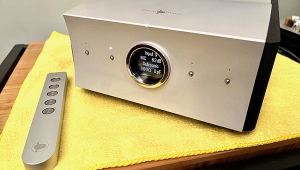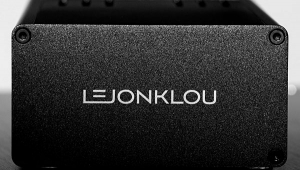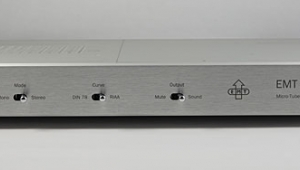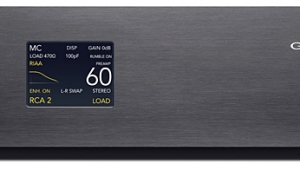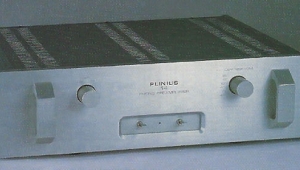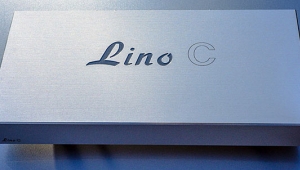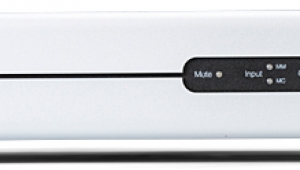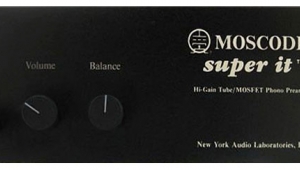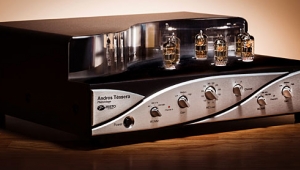| Columns Retired Columns & Blogs |
Graham Audio Era Gold Mk.V phono stage
I don't know Gram Slee from Gram Parsons, or which House he was in at Harry Potter's Hogwarts School, but let me tell you: If you'd just been listening to a bunch of budget phono preamps, as I had, then came upon the GSP Audio Era Gold Mk.V, you'd think someone had switched out not just the phono preamp but your entire system. You might think you were listening to a different pressing or a different cartridge. How can this be?
The GSP Audio Era Gold Mk.V is about twice as expensive as the Perreaux SXV1 and the Musical Fidelity XLPSv3, but it sounded at least 10 times better. It was amazingly dynamic, quiet, full-bodied, harmonically complete, supple, sensuous, and spectacular. It had nearly full dynamic expression at both ends of the scale, and absolutely astonishing bass performance. It made music sound almost as real as the really expensive stuff does, and it carried a 1000-lb tune with ease.
The Gold Mk.V requires a long burn-in period, but your patience will be rewarded. It's designed for high-output MCs or MMs of 2–10mV, and had plenty of gain (41.5dB) for the 2.5mV Sumiko Blackbird. It has no lights, no bells, no whistles, and a big regulated wall-wart. And unlike the budget Slee that I wrote about in June 2002, the Gold Mk.V has a nicely made aluminum case.
But you won't buy this one for its looks. Given its price and its miraculous—and this agnostic means miraculous—performance, I recommend the GSP Audio Era Gold Mk.V as enthusiastically, if not more so, as I've recommended any product I've reviewed and recommended in all the years I've been doing this. Instead of dropping $1500 on a new cartridge to use with your less-than-outstanding phono stage, spend your $1500 on a Sumiko Blackbird and a Gram Slee GSP Audio Era Gold Mk.V, and you could live happily ever after in analog land. I think I could, and I've been playing with ridiculously expensive stuff for years. This is one budget piece Bob Reina has to hear.—Michael Fremer
Robert J. Reina wrote about the GSP in January 2005 (Vol.28 No.1):
At the end of his favorable review of Graham Slee's GSP Audio Era Gold Mk.V phono stage (now $950) in January 2004, Michael Fremer exclaimed: "This is one budget piece Bob Reina has to hear." Them's fightin' words, Mikey. Sure, as an analog guy, I'm game-most of the listening that transpires during my reviews of affordable speakers is to original pressings of 1950s and '60s jazz LPs and Acoustic Sounds and Classic vinyl reissues, all reproduced via my trusty front-end of Rega Planar 3 turntable, Syrinx PU-3 tonearm, and Clearaudio Virtuoso Wood cartridge. I called Fremer to borrow his Era Gold for a while to give a listen, but he refused to let it out of his house. Which, of course, made me want to hear it even more.
After considerable break-in and warmup time, the Era Gold Mk.V sounded fabulous on a series of reference LPs. The midrange vocals on Janis Ian's Breaking Silence (Analogue Productions CAPP 027) were rich, detailed, and vibrant, without a trace of coloration, and there was excellent detail resolution in the high frequencies, with naturally clean but unexaggerated transients. Bass extension was forceful, clean, and tight, and dynamic range at both extremes was extended, linear, and natural.
On orchestral works such as Messiaen's Turangalîla Symphony (EMI UK SLS 5117), all instruments were placed with considerable detail, body, and ambience on a wide, deep soundstage. Piano reproduction was particularly impressive in terms of detail, timbre, and transient articulation. Bass-drum reproduction was deep, forceful, and dynamic, without a trace of overhang. On Dean Peer's Ucross (Jazz Planet JP 5002), Peer's electric bass was uncolored, fast, and articulate, and the lower register of his instrument shook the room.
I detected only a few flaws with the Era Gold Mk.V, and all of them were nits. I noticed, particularly on pop recordings, a very slight thickness in the upper bass that manifested itself on those tunes in which electric bass featured prominently in the mix. On classical recordings, the extreme upper registers of woodwind and percussion instruments seemed to lack a bit of top-end sparkle and air. Finally, when presented with highly modulated orchestral works such as the Messiaen, the Era Gold's overall presentation was a bit tense in the upper midrange, but only during the hairiest passages.
I compared the Era Gold to two phono stages with which I'm familiar: the EAR 834P (now $995, reviewed by me in July 1997 and by MF in August 2003), and the MMSE phono board ($130) added to my Creek 5350SE integrated amplifier. Each of these comparisons comes with a caveat. First, the stock tubes of the EAR, which I'd borrowed from a friend, had been replaced with new old stock Telefunken 12AX7s. Normally, I don't like "tube rolling" during a review, but EAR's US distributor does recommend NOS Telefunkens as an upgrade, and the unit I used had arrived without the original tubes for comparison. Also, although the circuitry of my Creek phono board is similar to that of Creek's OBH-15 standalone phono stage ($450), it's not identical; the OBH-15's circuits are slightly more elaborate, and it has its own power supply.
The EAR exhibited more detail, air, delicacy, and body in the midrange than the Era Gold Mk.V, as well as more detailed and extended highs. The EAR's bass performance was a bit rounder and slower than the Era Gold's, but which is the more natural and realistic will be a matter of taste. The EAR's dynamics were also superb, but in high-level passages it exhibited none of the tenseness I heard with the Era Gold. (Although it had been many years since I'd had an EAR in-house, this sample of the 834P had not a trace of the overall dark character I'd noted in my review of the original unit back in July 1997. I speculate that the upgrade to the Telefunken tubes is the main cause of the difference.)
The Creek phono board also exhibited a beautifully colorless midrange with excellent resolution of detail. The high frequencies were more extended than the Era Gold's, with transients that were even more refined. The bass seemed cleaner than both the Era Gold and the EAR, but low-bass extension and high-level dynamic slam seemed superior on the other two phono stages.
Mikey was right—Graham Slee's GSP Audio Era Gold Mk.V is a pip! I was very impressed with its performance, as well as with those of the EAR 834P (with tube upgrade) and the Creek phono board. All are highly recommended, depending on your taste and budget.—Robert J. Reina
- Log in or register to post comments
